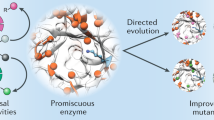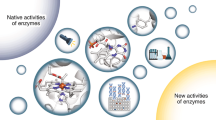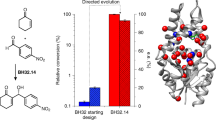Abstract
A dazzling array of enzymes is used by nature in making structurally complex natural products. These enzymes constitute a molecular toolbox that may be used in the construction and fine-tuning of pharmaceutically active molecules. Aided by technological advancements in protein engineering, it is now possible to tailor the activities and specificities of these enzymes as biocatalysts in the production of both natural products and their unnatural derivatives. These efforts are crucial in drug discovery and development, where there is a continuous quest for more potent agents. Both rational and random evolution techniques have been utilized in engineering these enzymes. This review will highlight some examples from several large families of natural products.





Similar content being viewed by others
References
Aaron J, Lin X, Cane DE, Christianson DW (2010) Structure of epi-isozizaene synthase from Streptomyces coelicolor A3(2), a platform for new terpenoid cyclization templates. Biochemistry 49(8):1787–1797
Abe I (2007) Enzymatic synthesis of cyclic triterpenes. Nat Prod Rep 24(6):1311–1331
Abe I, Morita H, Oguro S, Noma H, Wanibuchi K, Kawahara N, Goda Y, Noguchi H, Kohno T (2007) Structure-based engineering of a plant type III polyketide synthase: formation of an unnatural nonaketide naphthopyrone. J Am Chem Soc 129(18):5976–5980
Abe I, Utsumi Y, Oguro S, Morita H, Sano Y, Noguchi H (2005) A plant type III polyketide synthase that produces pentaketide chromone. J Am Chem Soc 127(5):1362–1363
Abe I, Watanabe T, Lou W, Noguchi H (2006) Active site residues governing substrate selectivity and polyketide chain length in aloesone synthase. FEBS J 273(1):208–218
Austin MB, Noel JP (2003) The chalcone synthase superfamily of type III polyketide synthases. Nat Prod Rep 20(1):79–110
Baerga-Ortiz A, Popovic B, Siskos AP, O’Hare HM, Spiteller D, Williams MG, Campillo N, Spencer JB, Leadlay PF (2006) Directed mutagenesis alters the stereochemistry of catalysis by isolated ketoreductase domains from the erythromycin polyketide synthase. Chem Biol 13(3):277–285
Bernhardt P, McCoy E, O’Connor SE (2007) Rapid identification of enzyme variants for re-engineered alkaloid biosynthesis in periwinkle. Chem Biol 14(8):888–897
Brautaset T, Sletta H, Degnes KF, Sekurova ON, Bakke I, Volokhan O, Andreassen T, Ellingsen TE, Zotchev SB (2011) New nystatin-related antifungal polyene macrolides with altered polyol region generated via biosynthetic engineering of Streptomyces noursei. Appl Environ Microbiol. doi:10.1128/AEM.05780-05711
Brautaset T, Sletta H, Nedal A, Borgos SE, Degnes KF, Bakke I, Volokhan O, Sekurova ON, Treshalin ID, Mirchink EP, Dikiy A, Ellingsen TE, Zotchev SB (2008) Improved antifungal polyene macrolides via engineering of the nystatin biosynthetic genes in Streptomyces noursei. Chem Biol 15(11):1198–1206
Challis G, Ravel J, Townsend CA (2000) Predictive, structure-based model of amino acid recognition by nonribosomal peptide synthetase adenylation domains. Chem Biol 7(3):211–224
Chan YA, Podevels AM, Kevany BM, Thomas MG (2009) Biosynthesis of polyketide synthase extender units. Nat Prod Rep 26(1):90–114
Chen C-Y, Georgiev I, Anderson AC, Donald BR (2009) Computational structure-based redesign of enzyme activity. Proc Natl Acad Sci USA 106(10):3764–3769
Chen S, Galan MC, Coltharp C, O’Connor SE (2006) Redesign of central enzyme in alkaloid biosynthesis. Chem Biol 13(11):1137–1141
Conti E, Stachelhaus T, Marahiel MA (1997) Structural basis for the activation of phenylalanine in the non-ribosomal biosynthesis of gramicidin. EMBO J 16(14):4174–4183
Cox RJ (2007) Polyketides, proteins and genes in fungi: programmed nano-machines begin to reveal their secrets. Org Biomol Chem 5(13):2010–2026
Cunningham F, Gantt E (2000) One ring or two? Determination of ring number in carotenoids by lycopene ε-cyclases. Proc Natl Acad Sci USA 98(5):2905–2910
Dang T, Prestwich GD (2000) Site-directed mutagenesis of squalene-hopene cyclase: altered substrate specificity and product distribution. Chem and Biol 7(8):643–649
Das A, Khosla C (2009) Biosynthesis of aromatic polyketides in bacteria. Acc Chem Res 42(5):631–639
Dewick PM (2002) The biosynthesis of C5–C25 terpenoid compounds. Nat Prod Rep 19(2):181–222
Ding W, Lei C, He Q, Zhang Q, Bi Y, Liu W (2010) Insights into bacterial 6-methylsalicylic acid synthase and its engineering to orsellinic acid synthase for spirotetronate generation. Chem Biol 17(5):495–503
Eppelmann K, Stachelhaus T, Marahiel MA (2002) Exploitation of the selectivity-conferring code of nonribosomal peptide synthetases for the rational design of novel peptide antibiotics. Biochemistry 41(30):9718–9726
Evans B, Chen Y, Metcalf WW, Zhao H, Kelleher NL (2011) Directed evolution of nonribosomal peptide synthetase AdmK generates new andrimid derivatives in vivo. Chem Biol 18(5):601–607
Ferrer JL, Jez JM, Bowman ME, Dixon RA, Noel JP (1999) Structure of chalcone synthase and the molecular basis of plant polyketide biosynthesis. Nat Struct Biol 6(8):775–784
Fischbach M, Lai JR, Roche ED, Walsh CT, Liu DR (2007) Directed evolution can rapidly improve the activity of chimeric assembly-line enzymes. Proc Natl Acad Sci USA 104(29):11951–11956
Fischbach MA, Walsh CT (2009) Antibiotics for emerging pathogens. Science 325(5944):1089–1093
Füll C (2001) Bicyclic triterpenes as new main products of squalene-hopene cyclase by mutation at conserved tyrosine residues. FEBS Lett 509(3):361–364
Gantt RW, Goff RD, Williams GJ, Thorson JS (2008) Probing the aglycon promiscuity of an engineered glycosyltransferase. Angew Chem Int Ed Engl 47(46):8889–8892
Gao X, Xie X, Pashkov I, Sawaya MR, Laidman J, Zhang W, Cacho R, Yeates TO, Tang Y (2009) Directed evolution and structural characterization of a simvastatin synthase. Chem Biol 16(10):1064–1074
Greenhagen B, Chappell J (2001) Molecular scaffolds for chemical wizardry: learning nature’s rules for terpene cyclases. Proc Natl Acad Sci USA 98(24):13479–13481
Greenhagen B, O’Maille PE, Noel JP, Chappell J (2006) Identifying and manipulating structural determinates linking catalytic specificities in terpene synthases. Proc Natl Acad Sci USA 103(26):9826–9831
Hahn M, Stachelhaus T (2004) Selective interaction between nonribosomal peptide synthetases is facilitated by short communication-mediating domains. Proc Natl Acad Sci USA 101(44):15585–15590
Hahn M, Stachelhaus T (2006) Harnessing the potential of communication-mediating domains for the biocombinatorial synthesis of nonribosomal peptides. Proc Natl Acad Sci USA 103(2):275–280
Hertweck C (2009) The biosynthetic logic of polyketide diversity. Angew Chem Int Ed Engl 48(26):4688–4716
Hertweck C, Luzhetskyy A, Rebets Y, Bechthold A (2007) Type II polyketide synthases: gaining a deeper insight into enzymatic teamwork. Nat Prod Rep 24(1):162–190
Hyatt D, Croteau R (2005) Mutational analysis of a monoterpene synthase reaction: Altered catalysis through directed mutagenesis of (-)-pinene synthase from Abies grandis. Arch Biochem Biophys 439(2):222–233
Kampranis S, Ioannidis D, Purvis A, Mahrez W, Ninga E, Katerelos NA, Anssour S, Dunwell JM, Degenhardt J, Makris A, Goodenough PW, Johnson CB (2007) Rational conversion of substrate and product specificity in a Salvia monoterpene synthase: Structural insights into the evolution of terpene synthase function. Plant Cell 19(6):1994–2005
Keatinge-Clay AT, Maltby DA, Medzihradszky KF, Khosla C, Stroud RM (2004) An antibiotic factory caught in action. Nat Struct Mol Biol 11(9):888–893
Khosla C, Kapur S, Cane DE (2009) Revisiting the modularity of modular polyketide synthases. Curr Opin Chem Biol 13(2):135–143
Kim W, Lee D, Hong SS, Na Z, Shin JC, Roh SH, Wu CZ, Choi O, Lee K, Shen YM, Paik SG, Lee JJ, Hong YS (2009) Rational biosynthetic engineering for optimization of geldanamycin analogues. Chembiochem 10(7):1243–1251
Kimura M, Kushiro T, Shibuya M, Ebizuka Y, Abe I (2010) Protostadienol synthase from Aspergillus fumigatus: Functional conversion into lanosterol synthase. Biochem Biophys Res Commun 391(1):899–902
Klundt T, Bocola M, Lutge M, Beuerle T, Liu B, Beerhues L (2009) A single amino acid substitution converts benzophenone synthase into phenylpyrone synthase. J Biol Chem 284(45):30957–30964
Kohzaki K, Gomi K, Yamasaki-Kokudo Y, Ozawa R, Takabayashi J, Akimitsu K (2009) Characterization of a sabinene synthase gene from rough lemon (Citrus jambhiri). J Plant Physiol 166(15):1700–1704
Kutchan TM (1993) Strictosidine: from alkaloid to enzyme to gene. Phytochemistry 32(3):493–506
Kwan DH, Leadlay PF (2010) Mutagenesis of a modular polyketide synthase enoylreductase domain reveals insights into catalysis and stereospecificity. ACS Chem Biol 5(9):829–838
Kwan DH, Sun Y, Schulz F, Hong H, Popovic B, Sim-Stark JC, Haydock SF, Leadlay PF (2008) Prediction and manipulation of the stereochemistry of enoylreduction in modular polyketide synthases. Chem Biol 15(11):1231–1240
Lai JR, Fischbach MA, Liu DR, Walsh CT (2006) Localized protein interaction surfaces on the EntB carrier protein revealed by combinatorial mutagenesis and selection. J Am Chem Soc 128(34):11002–11003
Leonard E, Ajikumar PK, Thayer K, Xiao W-H, Mo JD, Tidor B, Stephanopoulos G, Prather KLJ (2010) Combining metabolic and protein engineering of a terpenoid biosynthetic pathway for overproduction and selectivity control. Proc Natl Acad Sci USA 107(31):13654–13659
Lilien R, Stevens BW, Anderson AC, Donald BR (2005) A novel ensemble-based scoring and search algorithm for protein redesign and its application to modify the substrate specificity of the gramicidin synthetase A phenylalanine adenylation enzyme. J Comput Biol 12(6):740–761
Lodeiro S, Schulz-Gasch T, Matsuda SP (2005) Enzyme redesign: two mutations cooperate to convert cycloartenol synthase into an accurate lanosterol synthase. J Am Chem Soc 127(41):14132–14133
Loris E, Panjikar S, Ruppert M, Barleben L, Unger M, Schübel H (2007) Structure-based engineering of strictosidine synthase: auxiliary for alkaloid libraries. Chem Biol 14(9):979–985
Ma X, Panjikar S, Koepke J, Loris E, Stöckigt J (2006) The structure of Rauvolfia serpentina strictosidine synthase is a novel six-bladed β-propeller fold in plant proteins. Plant Cell 18(4):907–920
McDaniel R, Thamchaipenet A, Gustafsson C, Fu H, Betlach M, Ashley G (1999) Multiple genetic modifications of the erythromycin polyketide synthase to produce a library of novel “unnatural” natural products. Proc Natl Acad Sci USA 96(5):1846–1851
Meyer M, Xu R, Matsuda SPT (2002) Directed evolution to generate cycloartenol synthase mutants that produce lanosterol. Org Lett 4(8):1395–1398
Mijts B, Lee PC, Schmidt-Danner C (2006) Identification of a carotenoid oxygenase synthesizing acyclic xanthophylls: combinatorial biosynthesis and directed evolution. Chem Biol 12(4):453–460
Moore BS, Hertweck C (2002) Biosynthesis and attachment of novel bacterial polyketide synthase starter units. Nat Prod Rep 19(1):70–99
Morita H, Kondo S, Oguro S, Noguchi H, Sugio S, Abe I, Kohno T (2007) Structural insight into chain-length control and product specificity of pentaketide chromone synthase from Aloe arborescens. Chem Biol 14(4):359–369
Morrone D, Xu M, Fulton DB, Determan MK, Peters RJ (2008) Increasing complexity of a diterpene synthase reaction with a single residue switch. J Am Chem Soc 130(16):5400–5401
Nawarathne IN, Walker KD (2010) Point mutations (Q19P and N23K) increase the operational solubility of a 2alpha-O-benzoyltransferase that conveys various acyl groups from CoA to a taxane acceptor. J Nat Prod 73(2):151–159
Nguyen KT, Ritz D, Gu JQ, Alexander D, Chu M, Miao V, Brian P, Baltz RH (2006) Combinatorial biosynthesis of novel antibiotics related to daptomycin. Proc Natl Acad Sci USA 103(46):17462–17467
O’Hare HM, Baerga-Ortiz A, Popovic B, Spencer JB, Leadlay PF (2006) High-throughput mutagenesis to evaluate models of stereochemical control in ketoreductase domains from the erythromycin polyketide synthase. Chem Biol 13(3):287–296
Patel H, Walsh CT (2001) In vitro reconstitution of the Pseudomonas aeruginosa nonribosomal peptide synthesis of Pyochelin: characterization of backbone tailoring thiazoline reductase and N-methyltransferase activities. Biochemistry 40(30):9023–9031
Peters RJ, Croteau RB (2003) Alternative termination chemistries utilized by monoterpene cyclases: chimeric analysis of bornyl diphosphate, 1, 8-cineole, and sabinene synthases. Arch Biochem Biophys 417(2):203–211
Power P, Dunne T, Murphy B, Nic Lochlainn L, Rai D, Borissow C, Rawlings B, Caffrey P (2008) Engineered synthesis of 7-oxo- and 15-deoxy-15-oxo-amphotericins: insights into structure-activity relationships in polyene antibiotics. Chem Biol 15(1):78–86
Ramos A, Olano C, Brana AF, Mendez C, Salas JA (2009) Modulation of deoxysugar transfer by the elloramycin glycosyltransferase ElmGT through site-directed mutagenesis. J Bacteriol 191(8):2871–2875
Reeves CD, Murli S, Ashley GW, Piagentini M, Hutchinson CR, McDaniel R (2001) Alteration of the substrate specificity of a modular polyketide synthase acyltransferase domain through site-specific mutations. Biochemistry 40(51):15464–15470
Reid R, Piagentini M, Rodriguez E, Ashley G, Viswanathan N, Carney J, Santi DV, Hutchinson CR, McDaniel R (2003) A model of structure and catalysis for ketoreductase domains in modular polyketide synthases. Biochemistry 42(1):72–79
Rix U, Fischer C, Remsing LL, Rohr J (2002) Modification of post-PKS tailoring steps through combinatorial biosynthesis. Nat Prod Rep 19(5):542–580
Schmidt-Dannert C, Umeno D, Arnold FH (2000) Molecular breeding of carotenoid biosynthetic pathways. Nat Biotechnol 18(7):750–753
Schwarzer D, Finking R, Marahiel MA (2003) Nonribosomal peptides: from genes to products. Nat Prod Rep 20(3):275–287
Segura M, Lodiero S, Meyer MM, Patel AJ, Matsuda SPT (2002) Directed evolution experiments reveal mutations at cycloartenol synthase residue His477 that dramatically alter catalysis. Org Lett 4(25):4459–4462
Shishova E, Di Constanzo L, Cane DE, Christianson DW (2007) X-ray crystal structure of aristolochene synthase from Aspergillus terreus and evolution of templates for the cyclization of farnesyl diphosphate. Biochemistry 46(7):1941–1951
Sieber SA, Marahiel MA (2005) Molecular mechanisms underlying nonribosomal peptide synthesis: approaches to new antibiotics. Chem Rev 105(2):715–738
Stachelhaus T, Marahiel MA (1995) Modular structure of peptide synthetases revealed by dissection of the multifunctional enzyme GrsA. J Biol Chem 270(11):6163–6169
Stachelhaus T, Mootz HD, Marahiel MA (1999) The specificity-conferring code of adenylation domains in nonribosomal peptide synthetases. Chem Biol 6(8):493–505
Stachelhaus T, Schneider A, Marahiel MA (1995) Rational design of peptide antibiotics by targeted replacement of bacterial and fungal domains. Science 269(5220):69–72
Starks C, Back K, Chappell J, Noel JP (1997) Structural basis for cyclic terpene biosynthesis by tobacco 5-epi-Aristolochene synthase. Nature 277(5333):1815–1820
Staunton J, Weissman KJ (2001) Polyketide biosynthesis: a millennium review. Nat Prod Rep 18(4):380–416
Steele CL, Crock J, Bohlmann J, Croteau R (1998) Sesquiterpene synthases from grand fir (Abies grandis) - Comparison of constitutive and wound-induced activities, and cDNA isolation, characterization and bacterial expression of delta-selinene synthase and gamma-humulene synthase. J Biol Chem 273(4):2078–2089
Tang Y, Tsai SC, Khosla C (2003) Polyketide chain length control by chain length factor. J Am Chem Soc 125(42):12708–12709
Uguru G, Milne C, Borg M, Flett F, Smith CP, Micklefield J (2004) Active-site modifications of adenylation domains lead to hydrolysis of upstream nonribosomal peptidyl thioester intermediates. J Am Chem Soc 126(16):5032–5033
Umeno D, Arnold FH (2004) Evolution of a pathway to novel long-chain carotenoids. J Bacteriol 186(5):1531–1536
Umeno D, Tobias AV, Arnold FH (2005) Diversifying carotenoid biosynthetic pathways by directed evolution. Microbiol Mol Biol R 69(1):51–78
Walter MH, Strack D (2011) Carotenoids and their cleavage products: biosynthesis and functions. Nat Prod Rep 28(4):663–692
Wang C-W, Liao JC (2001) Alteration of product specificity of Rhodobacter sphaeroides phytoene desaturase by directed evolution. J Biol Chem 276(44):41161–41164
Wang C-W, Oh M-K, Liao JC (2000) Directed evolution of metabolically engineered Escherichia coli for carotenoid production. Biotechnol Prog 16(6):922–926
Watanabe K, Hotta K, Praseuth AP, Koketsu K, Migita A, Boddy CN, Wang CC, Oguri H, Oikawa H (2006) Total biosynthesis of antitumor nonribosomal peptides in Escherichia coli. Nat Chem Biol 2(8):423–428
Watanabe K, Hotta K, Praseuth AP, Searcey M, Wang CCC, Oguri H, Oikawa H (2009) Rationally engineered total biosynthesis of a synthetic analogue of a natural quinomycin depsipeptide in Escherichia coli. ChemBioChem 10(12):1965–1968
Weissman KJ, Leadlay PF (2005) Combinatorial biosynthesis of reduced polyketides. Nat Rev Microbiol 3(12):925–936
Whittington DA, Wise ML, Urbansky M, Coates RM, Croteau RB, Christianson DW (2002) Bornyl diphosphate synthase: structure and strategy for carbocation manipulation by a terpenoid cyclase. Proc Natl Acad Sci USA 99(24):15375–15380
Wilderman PR, Peters RJ (2007) A single residue switch converts abietadiene synthase into a pimaradiene specific cyclase. J Am Chem Soc 129(51):15736–15737
Williams GJ, Goff RD, Zhang C, Thorson JS (2008) Optimizing glycosyltransferase specificity via “hot spot” saturation mutagenesis presents a catalyst for novobiocin glycorandomization. Chem Biol 15(4):393–401
Williams GJ, Zhang C, Thorson JS (2007) Expanding the promiscuity of a natural-product glycosyltransferase by directed evolution. Nat Chem Biol 3(10):657–662
Wu T-K, Wen HY, Chang C-H, Liu Y-T (2008) Protein plasticity: a single amino acid substitution in the Saccharomyces cerevisiae oxidosqualene-lanosterol cyclase generates Protosta-13(17), 24-dien-3b-ol, a rearrangement product. Org Lett 10(12):2529–2532
Xiang H, Tschirret-Guth RA, Ortiz De Montellano PR (2000) An A245T mutation conveys on cytochrome P450eryF the ability to oxidize alternative substrates. J Biol Chem 275(46):35999–36006
Xie XK, Watanabe K, Wojcicki WA, Wang CCC, Tang Y (2006) Biosynthesis of lovastatin analogs with a broadly specific acyltransferase. Chem Biol 13:1161–1169
Xu M, Wilderman PR, Peters RJ (2007) Following evolution’s lead to a single residue switch for diterpene synthase product outcome. Proc Natl Acad Sci USA 104(18):7397–7401
Yang L, Stöckigt J (2010) Trends for diverse production strategies of plant medicinal alkaloids. Nat Prod Rep 27(10):1469–1479
Yoshikuni Y, Dietrich FA, Nowroozi FF, Babbitt PC, Keasling JD (2008) Redesigning enzymes based on adaptive evolution for optimal function in synthetic metabolic pathways. Chem Biol 15(6):607–618
Yoshikuni Y, Ferrin TE, Keasling JD (2006) Designed divergent evolution of enzyme function. Nature 440(7087):1078–1082
Yoshikuni Y, Martin VJJ, Ferrin TE, Keasling JD (2006) Engineering cotton (+)-d-cadinene synthase to an altered function: germacrene d-4-ol synthase. Chem Biol 13(1):91–98
Zhou H, Xie X, Tang Y (2008) Engineering natural products using combinatorial biosynthesis and biocatalysis. Curr Opin Biotechnol 19(6):590–596
Zocher G, Richter ME, Mueller U, Hertweck C (2011) Structural fine-tuning of a multifunctional cytochrome P450 monooxygenase. J Am Chem Soc 133(7):2292–2302
Acknowledgments
Due to space constraints, we apologize for any work that we were not able to cite. Related projects in our laboratory are supported by the NIH, David and Lucile Packard, Alfred Sloan and Dreyfus Foundations. R. Cacho and A. Zabala are supported by the NIH predoctoral training grants.
Author information
Authors and Affiliations
Corresponding author
Additional information
Angelica O. Zabala and Ralph A. Cacho contributed equally to this work.
Rights and permissions
About this article
Cite this article
Zabala, A.O., Cacho, R.A. & Tang, Y. Protein engineering towards natural product synthesis and diversification. J Ind Microbiol Biotechnol 39, 227–241 (2012). https://doi.org/10.1007/s10295-011-1044-2
Received:
Accepted:
Published:
Issue Date:
DOI: https://doi.org/10.1007/s10295-011-1044-2




